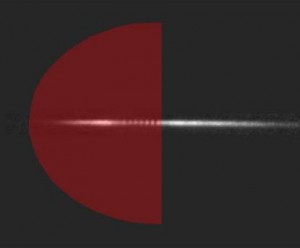Hawking Radiation

We recently made the first observation of thermal, quantum Hawking radiation in any system. We created an analogue black hole in an atomic Bose-Einstein condensate. The point where the condensate flowed at the speed of sound was analogous to the event horizon. This sonic horizon was seen to emit an approximately thermal distribution of Hawking radiation. Each Hawking phonon exiting the black hole had a partner particle falling into the black hole. Using a technique which we developed, we saw that these pairs were entangled. This entanglement verifies a crucial element in the discussion of the information paradox as well as the firewall controversy.
In 2014, we made the first observation of Hawking radiation in any system. Both an outer event horizon and an inner horizon were present, in analogy with a charged black hole. This configuration, in combination with the superluminal dispersion relation of the condensate, resulted in self-amplifying Hawking radiation. That is to say, the Hawking radiation reflected from the inner horizon, returned to the outer horizon, and caused additional Hawking radiation.
In a landmark combination of general relativity and quantum field theory, Stephen Hawking predicted that a black hole should emit Hawking radiation. The effective temperature of the radiation was in striking agreement with the effective temperature of the entropy of the black hole, predicted by Jacob Bekenstein. Alas, the radiation is too weak to observe with current techniques. Thus, William Unruh proposed that the observation could be made in an analogue black hole in the laboratory. Later, Corley and Jacobson suggested that in the presence of two horizons, the Hawking radiation will reflect between the horizons, stimulating more Hawking radiation each round trip.
Until our recent work, the observation of Hawking radiation was a “holy grail” for the fields of atomic physics, nonlinear optics, solid state physics, condensed matter superfluids, astrophysics, cosmology, and particle physics. It has been proposed that Hawking radiation could be observed in very small real black holes, in atomic Bose-Einstein condensates, in superfluid 3He, in an electromagnetic waveguide, in a gas of ultracold fermions, in a ring of trapped ions, in slow light in an atomic vapor, in light in a nonlinear liquid, and in an exciton-polariton condensate. When waves generated in water were allowed to scatter from an analog white hole horizon, mode conversion as required for the Hawking process was observed. Also, nonlinear optical fibers containing horizons were seen to emit photons, but this was due to effects other than Hawking radiation.
See the Phonons and Correlations section for the intermediate results required to observe Hawking radiation.
Related Publications
- V. I. Kolobov, K. Golubkov, J. R. M. de Nova, and J. Steinhauer, Observation of stationary spontaneous Hawking radiation and the time evolution of an analogue black hole, Nature Phys. 17, 362 (2021).
- Juan Ramón Muñoz de Nova, Katrine Golubkov, Victor I. Kolobov, and Jeff Steinhauer, Observation of thermal Hawking radiation and its temperature in an analogue black hole, Nature 569, 688 (2019).
- Steinhauer, J. Observation of quantum Hawking radiation and its entanglement in an analogue black hole. Nature Phys. 12, 959 (2016).
- Steinhauer, J. Measuring the entanglement of analogue Hawking radiation by the density-density correlation function. Phys. Rev. D 92, 024043 (2015).
- Steinhauer, J. Observation of self-amplifying Hawking radiation in an analogue black-hole laser. Nature Phys. 10, 864 (2014).
- Lahav, O., Itah, A., Blumkin, A., Gordon, C., Rinott, S., Zayats, A. & Steinhauer, J. Realization of a sonic black hole analog in a Bose-Einstein condensate. Phys. Rev. Lett. 105, 240401 (2010).

